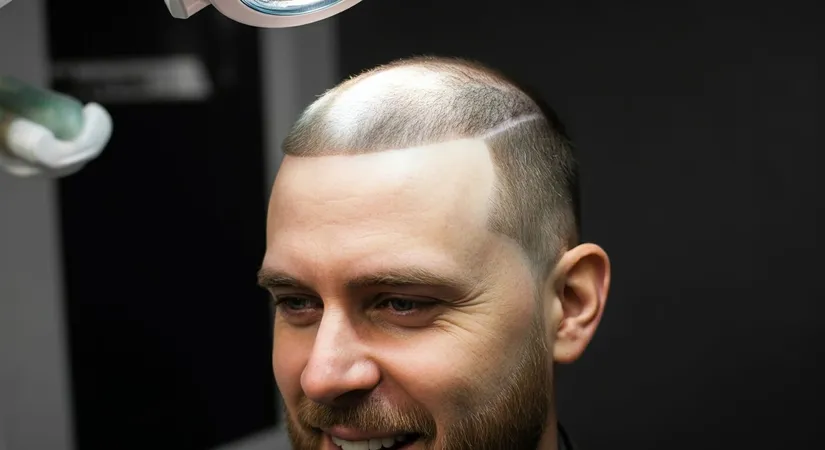Choosing the Best Hair Transplant Doctor: A Comprehensive Guide
Your guide to selecting the expert hair transplant doctor for optimal results.
Finding the right hair transplant doctor is crucial for a successful hair restoration journey. With advancements in medical technology, there are now various techniques and considerations to keep in mind when choosing the best expert for your needs. This guide will help you navigate those choices effectively, covering essential aspects like the role of a hair transplant doctor, selection criteria, surgery techniques, and expert reviews to guide your decision-making. Ensure your journey towards hair restoration is informed, confident, and successful with the insights provided here.
Understanding the Role of a Hair Transplant Doctor
Key Responsibilities of a Hair Transplant Doctor
A hair transplant doctor specializes in restoring hair to areas affected by hair loss. They possess a deep understanding of scalp anatomy, which is crucial for achieving natural-looking results. These specialists are adept at various techniques, such as follicular unit extraction, to ensure successful hair restoration.
- Expertise in scalp anatomy for precise hair follicle transplantation.
- Proficiency in advanced techniques like follicular unit extraction.
- Ability to create natural-looking hairlines and density.
For instance, a skilled hair transplant doctor can transform a receding hairline into a fuller, more youthful appearance, enhancing a patient's confidence.
Choosing the Best Hair Transplant Doctor
Selecting the right hair transplant doctor is crucial for a successful outcome. Factors to consider include the doctor's experience, patient reviews, and the techniques they employ. A well-reviewed doctor with a track record of successful surgeries is often a reliable choice.
- Research the doctor's experience and specialization in hair restoration.
- Read patient reviews to gauge satisfaction and outcomes.
- Evaluate the techniques used, such as follicular unit extraction.
By following these steps, individuals can find a doctor who meets their needs and expectations, ensuring a positive hair transplant experience.

How to Choose a Hair Transplant Doctor: Key Considerations
Evaluating Experience and Technology
When selecting a hair transplant doctor, prioritize those with extensive experience and a history of successful surgeries. A seasoned doctor is more likely to handle complex cases effectively. For example, a doctor with over a decade of experience in hair restoration can offer insights and solutions that newer practitioners might not.
- Look for doctors who have performed numerous surgeries using advanced techniques.
- Ensure the clinic uses the latest technology, such as robotic assistance for precision.
- Check if the doctor is involved in ongoing research or training to stay updated.
Advanced technology, like robotic follicular unit extraction, enhances precision and reduces recovery time, making it a crucial factor in your decision.
Understanding Hair Transplant Techniques
Different techniques, such as Follicular Unit Extraction (FUE) and Direct Hair Implantation (DHI), require specific expertise. Understanding these methods helps in choosing a doctor who specializes in the technique best suited for your needs.
- Research the various hair transplant techniques available.
- Identify which technique aligns with your hair restoration goals.
- Select a doctor with proven expertise in your chosen method.
For instance, if you prefer a minimally invasive procedure, a doctor specializing in FUE might be ideal. This method involves extracting individual follicles, which can result in a more natural look with less scarring.

Exploring Hair Transplant Surgery Techniques
Innovative Hair Transplant Methods
Hair transplant surgery has evolved significantly, offering various techniques tailored to individual needs. Among the most popular methods are Follicular Unit Extraction (FUE), Direct Hair Implantation (DHI), and the latest Multi-Implanter techniques. Each of these methods provides unique benefits, making it crucial to understand their differences when considering hair restoration.
- FUE: This method involves extracting individual hair follicles from the donor area and implanting them into the balding area. It is minimally invasive and leaves no linear scars, making it a preferred choice for many.
- DHI: Direct Hair Implantation uses a specialized tool to implant hair follicles directly into the scalp, allowing for precise control over the angle, depth, and direction of each follicle.
- Multi-Implanter: This cutting-edge technique allows for the simultaneous implantation of multiple follicles, significantly reducing the time required for the procedure and enhancing efficiency.
These innovative methods cater to different needs, such as minimizing recovery time or achieving a natural hairline, providing patients with options that best suit their goals.
Choosing the Right Technique for You
Selecting the appropriate hair transplant technique depends on various factors, including hair type, desired outcome, and personal preferences. Understanding these elements can guide individuals in making informed decisions about their hair restoration journey.
- Assess Your Hair Type: Different techniques may be more suitable for specific hair types. For instance, FUE is often recommended for those with finer hair.
- Define Your Goals: Consider what you hope to achieve with the transplant, such as increased density or a natural-looking hairline.
- Consult with a Specialist: A hair restoration specialist can provide insights into which technique aligns best with your needs and expectations.
By evaluating these factors, individuals can choose a method that not only meets their aesthetic goals but also aligns with their lifestyle and recovery preferences.
Hair Transplant Doctor Reviews: What to Look For
Evaluating Expertise and Patient Satisfaction
When assessing hair transplant doctor reviews, focus on the doctor's expertise and commitment to patient satisfaction. Reviews often highlight the doctor's ability to deliver natural-looking results, which is crucial for anyone considering hair transplant surgery. For example, a review might mention how a doctor successfully restored a patient's hairline, enhancing their overall appearance.
- Look for reviews that emphasize the doctor's skill in achieving natural results.
- Consider feedback on the doctor's communication and aftercare support.
- Note any recurring themes of patient satisfaction and successful outcomes.
These insights can guide you in selecting a doctor who not only meets your aesthetic goals but also provides a supportive and reassuring experience throughout the process.
Understanding the Importance of Aftercare
Aftercare is a critical component of the hair transplant process, and reviews often reflect the level of care provided post-surgery. A doctor who offers comprehensive aftercare ensures that patients experience a smooth recovery and achieve optimal results. For instance, reviews might highlight how a doctor provided detailed post-operative instructions and regular follow-ups, contributing to a successful recovery.
- Check if reviews mention thorough post-surgery instructions and support.
- Look for feedback on the availability of the doctor for follow-up consultations.
- Evaluate the overall satisfaction with the recovery process as described by patients.
By focusing on these aspects, you can identify a doctor who prioritizes patient care and ensures a positive experience from consultation to recovery.
Latest Trends and Techniques in Hair Transplantation
Advancements in Hair Transplant Techniques
Recent advancements in hair transplant techniques have significantly improved the success rates and outcomes of these procedures. One notable innovation is the integration of Platelet-Rich Plasma (PRP) therapy, which enhances hair growth and accelerates healing. PRP involves using a patient's own blood components to stimulate hair follicles, promoting healthier and denser hair growth.
- PRP therapy enhances follicle vitality and accelerates recovery.
- Robotic assistance in follicular unit extraction ensures precision.
- Advanced imaging techniques for accurate hairline design.
These advancements not only improve the aesthetic results but also reduce downtime, making hair transplant surgery more appealing to a broader audience.
Exploring the Cost Factors in Hair Transplantation
While discussing the latest techniques, it's essential to understand the various factors influencing the cost of hair transplant procedures. These include the complexity of the chosen technique, the extent of hair loss, and the expertise of the hair transplant doctor. Additionally, the incorporation of advanced technologies and therapies, such as PRP, can also impact the overall investment required for the procedure.
- Technique complexity and required expertise.
- Extent of hair loss and desired coverage.
- Use of advanced technologies and therapies.
Understanding these factors can help individuals make informed decisions about their hair restoration journey, ensuring they select the most suitable options for their needs and expectations.
Questions to Ask Your Hair Transplant Doctor
Understanding Potential Risks and Recovery
Before undergoing hair transplant surgery, it's essential to discuss potential risks with your hair transplant doctor. Understanding these risks helps in setting realistic expectations and preparing for any possible complications. For instance, some patients might experience temporary swelling or minor discomfort post-surgery, which is typically manageable with proper care.
- Inquire about common side effects and how to mitigate them.
- Ask about the likelihood of complications specific to your health profile.
- Understand the measures taken to ensure a safe procedure.
These discussions not only prepare you for the surgery but also help in building trust with your doctor, ensuring a smoother experience.
Setting Realistic Expectations for Recovery
Recovery timelines can vary based on individual health and the specific technique used. It's crucial to discuss these timelines with your doctor to plan accordingly. For example, while some patients might resume normal activities within a week, others may require more time for optimal healing.
- Discuss the expected duration of the recovery period.
- Understand the stages of hair growth post-surgery.
- Clarify any restrictions on activities during recovery.
By having a clear understanding of the recovery process, you can manage your expectations and ensure a successful outcome from your hair transplant surgery.
Innovative Hair Transplant Techniques for Natural Results
Comprehensive Hair Transplant Process with Patient-Centric Care
Frequently Asked Questions
What does a hair transplant doctor do?
How to choose the best hair transplant doctor?
What are the latest techniques in hair transplant surgery?
What should I look for in hair transplant doctor reviews?
How important is aftercare in the hair transplant process?
Discover the path to 'Healthy Beauty' with estethica's expert care. Call now for your free consultation and take the first step towards a more confident you!
📞 Call for Your Free Consultation